 |
SORTING THROUGH THE PAST – DISCOVERIES MADE AND QUESTIONS RAISED
BY NANCY HEWISON |
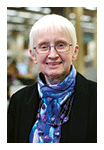 Moving to a new job, a new office, or a new phase of one’s life (retirement in my case) can involve a lot of work, as I discovered while sorting through emails and documents from my 32 years in the Libraries. I inherited most of those in paper format when a colleague retired in 1996 and took on many of the responsibilities I have today. In the process of determining which items to give to Archives and Special Collections (subject to review by ASC staff), and which to recycle, I’m making some curious discoveries. Here are some of them, along with the labels I’ve given to each item and the questions the items raise for me. Hope you enjoy this brief look into the Libraries’ past! Moving to a new job, a new office, or a new phase of one’s life (retirement in my case) can involve a lot of work, as I discovered while sorting through emails and documents from my 32 years in the Libraries. I inherited most of those in paper format when a colleague retired in 1996 and took on many of the responsibilities I have today. In the process of determining which items to give to Archives and Special Collections (subject to review by ASC staff), and which to recycle, I’m making some curious discoveries. Here are some of them, along with the labels I’ve given to each item and the questions the items raise for me. Hope you enjoy this brief look into the Libraries’ past!
Wouldn’t happen today – Item: Photograph of a sign displayed outside the door of the Chemistry Library in 1987, when nearly all library materials were in print and those designated as reference books typically could not be borrowed and taken out of the library. The sign said “Chemistry Library Carrels are reserved for users of library materials.” Question: What happened to the occupant of a carrel caught reading a math text or studying for a history exam?
Technology marches on – Item: Announcement by the University in 1994, when desktop phones with numeric key pads were replacing those with rotary dials: “The Voice Mail messaging system is now available at Purdue for $8.50/month with no set-up fee.” Training sessions were available as well as FAQ’s, including “Can I access my mailbox from a rotary phone?” The answer: “If you know you’ll be in an area with rotary phones, you will need to carry a tone generator with you. These are pocket size and are available at stores such as Radio Shack or Service Merchandise.” Question: How big a pocket?
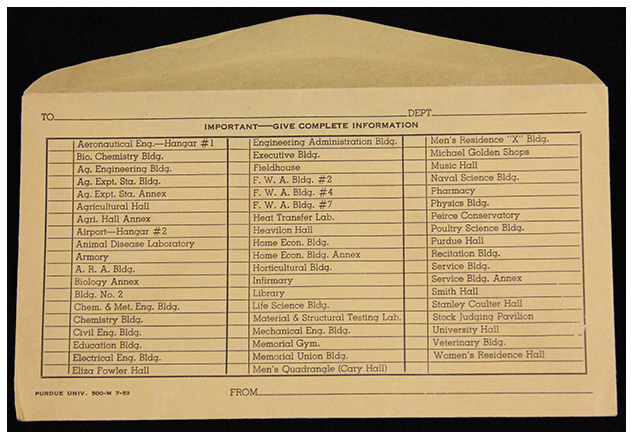 Most intriguing find so far – Item: A small envelope, apparently designed for inter-office mail although its dimensions barely exceed those of a dollar bill. Fifty-six delivery locations are listed in tiny print on the front of the envelope, including “Library” and the mysterious “A.R.A. Bldg.” and “Bldg. No. 2.” Question: How old is this small envelope and what were its intended contents? Most intriguing find so far – Item: A small envelope, apparently designed for inter-office mail although its dimensions barely exceed those of a dollar bill. Fifty-six delivery locations are listed in tiny print on the front of the envelope, including “Library” and the mysterious “A.R.A. Bldg.” and “Bldg. No. 2.” Question: How old is this small envelope and what were its intended contents?
A point of pride and a force for good to the present day – Item: A 1996 memo announcing the creation of the Libraries Ergonomics Action team. Based on the report of a Libraries task force and charged with the goal of preventing ergonomic-related injuries in the Libraries, the new team developed an ergonomics program at a time when no such structured program existed on campus. The resulting approach was also used as a model by the leadership of Radiological and Environmental Management (REM) to create a service providing resources for basic ergonomics training and preventive workstation assessment campus-wide. The Libraries action team evolved into the present Safety and Ergonomics Committee, a group that continues to actively address ergonomics and safety in the Libraries. Question: Isn’t it great that we just keep on demonstrating what the people of the Purdue Libraries can accomplish? |
 |
LEARNING COUNCIL "INNOVATION FUNDS" AWARDS
BY SHARON WEINER |
The Learning Council is pleased to announce the first awards for projects funded through the “Libraries Faculty Innovation Funds” program. Libraries faculty could apply for funds to develop or revise courses, workshops, or other learning experiences that they teach or plan to teach. The learning experience ideally will include aspects of information literacy, research data management and scholarly communication. This is to support the Libraries goal of teaching or co-teaching courses. Projects must be completed by December 1.
Congratulations to the recipients of the funding! They are:
- Bethany McGowan, $2,485 for “Redesigning NUR 223: Foundations of Nursing Research and Evidence Based Practice.”
- Ilana Stonebraker, $1,927 for “MGMT 190: Mapping the Curriculum for Better Course Integration.”
- Wei Zakharov, $2,665 for “Integrating Information Literacy Learning Module into Online Courses at Purdue.”
The members of the Learning Council are Scott Brandt, Michael Flierl, Tracy Grimm, Erla Heyns, Nastasha Johnson, Vicki Killion, Clarence Maybee, Sammie Morrie, Amy Van Epps, Sharon Weiner (Chair). |
 |
BIG TEN ACADEMIC ALLIANCE @ PURDUE
|
In addition to moving books to the newly consolidated Library of Engineering & Science, Purdue University Libraries in the Wilmeth Active Learning Center last week, Purdue University Libraries' faculty and staff members served as the hosts of the "Big Ten Academic Alliance Collective Collection: Leveraging a Legacy to Shape Our Shared Future” conference. The Big Ten Academic Alliance (BTAA), formerly the Committee on Institutional Cooperation (CIC), is the academic consortium of the universities in the Big Ten Conference. The consortium was renamed on June 29, 2016.
The 2017 Big Ten Academic Alliance Library Conference explored how member research libraries can move from legacy Cooperative Collection Development (CCD) activities to a more holistic environment that leverages robust discovery, digitization, delivery, and shared service environments to advance and shape the collective collection. With a trust relationship shaped from over 50 years of coordinated action in the BTAA libraries, the conference looked at current activities such as coordinated licensing and shared print storage to explore:
Alignment of prospective collection building
Expanded digitization activities
Coordinated technical services
Robust preservation infrastructure
Sophisticated resource sharing and delivery systems
Strategic partnerships that advance collective goal
Program Planning Committee included Rebecca Richardson (Purdue); Bryan Skib (Michigan); D.J. Hoek (Northwestern); Tom Teper (Illinois); Karla Strieb (Ohio State).
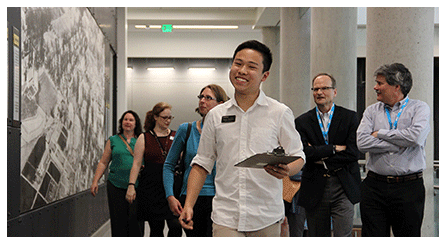
On May 16, conference attendees (seen here being led by Purdue University Student Ambassador Sebastian Kenny) were among the first individuals outside of Purdue to tour the new Thomas S. and Harvey D. Wilmeth Active Learning Center and learn about the vision for this 21st century library and teaching and learning facility, which was built on the former site of the Purdue Power Plant. |
 |
THE CONTINUING LIBRARY ADVENTURES
OF DAN & DAN
BY DAN ROTELLO |
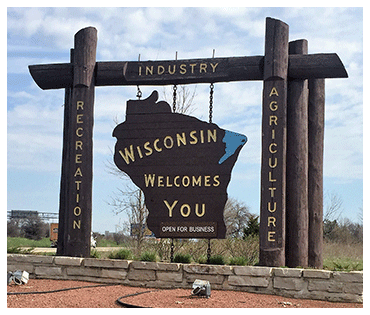 On April 12, 2017, Dan Yeoman and I set forth on our third off-campus mission for Purdue University Libraries. Our two previous trips involved picking up materials from two of Purdue’s alumni astronauts, Captain Eugene Cernan (May 2010) and Neil Armstrong (2013) after his death. On this trip, we were given the task of picking up material from The University of Wisconsin Library. This collection was 160 volumes of their library’s copy of The National Union Catalog of Pre-1956 Imprints (NUC), which would remain on indefinite loan to the Purdue Libraries. On April 12, 2017, Dan Yeoman and I set forth on our third off-campus mission for Purdue University Libraries. Our two previous trips involved picking up materials from two of Purdue’s alumni astronauts, Captain Eugene Cernan (May 2010) and Neil Armstrong (2013) after his death. On this trip, we were given the task of picking up material from The University of Wisconsin Library. This collection was 160 volumes of their library’s copy of The National Union Catalog of Pre-1956 Imprints (NUC), which would remain on indefinite loan to the Purdue Libraries.
The NUC, also known as The Mansell Collection after its publisher, is a set of 754 volumes, is a massive bibliography complied between 1968 and 1981. It contains photocopies of printed catalog cards on works published before 1956 that are held by major American and Canadian libraries. This collection was an important resource in finding copies of books before the advent of large electronic bibliographic databases, such as OCLC’s WorldCat. Even though the huge size and weight of the NUC makes it less practical, it remains a valuable tool for research.
Dean Mullins has a particular fondness for this catalog due to the joy the arrival of the newest four or five volumes brought to him and the other catalogers in the 1970s.
“It meant that we no longer had to search multiple volumes to find a single cataloging record. Begun in 1968, long before OCLC was a twinkle in Fred Kilgour’s eye, it continued to be cumulated and published until 1981. However, by the time the final volume (number 754) was completed, it was totally superseded by the advent of OCLC. It will forever be the single largest publishing endeavor ever undertaken and probably the heaviest (weight three tons),” he noted.
Although not as exciting as meeting the last man on the moon, or as interesting as talking with the widow of the first man on the moon, this adventure had its own cool purpose. These attractive volumes would adorn the Reading Room’s display cases in the new Wilmeth Active Learning Center.
Our adventure started at 6 a.m. that Wednesday morning in a white Purdue van with the rear seats taken out. The first challenge of the trip came while going through Chicago at 8 a.m. The sea of vehicles during rush hour traffic slowed our progress north. Traffic started to move faster as we neared the Wisconsin border. We made good time after that and arrived at the State Capital, Madison. If one-way streets confuse you, DO NOT drive in Madison. These streets even confused our GPS device.
The Library there is surrounded by one-ways and its street address is on one side of the building, and the loading dock is off a different one-way street. Dan and I started to sound like a married couple in need of counseling while attempting to navigate through Madison. We were finally directed in by cell phone and arrived at the dock around noon.
The Wisconsin Library staff brought out the collection on book trucks and we loaded up the back of our van with 32 boxes. Lunchtime was spent at UW’s version of Harry’s Chocolate Shop, State Street Brats. After some tasty burgers and fries, we headed back to Indiana.
Unfortunately, we arrived in Chicago during evening rush hour and inched along. Once we got on 65 south, things went great and we made excellent time back to campus. We unloaded the 32 boxes on a cart at the Libraries’ dock, turned the van back in to Transportation and headed home after the completion of another successful Library mission.
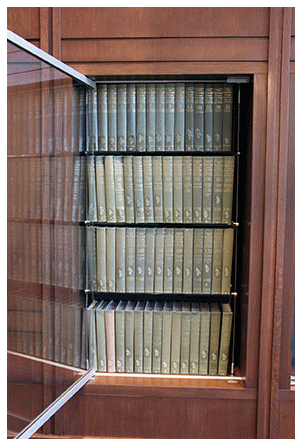 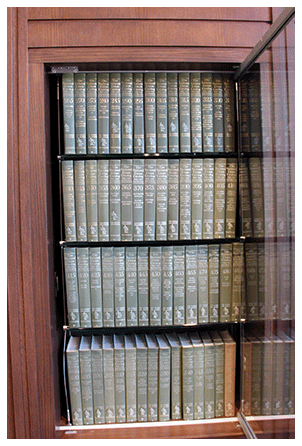 Seeing the National Union Catalog in the Reading Room during the Big Ten Library Conference reception, I realized how appropriate it was to have this collection in the WALC. There has been great effort made to honor and celebrate the history and evolution of this space on campus. People can see the importance and influence of the past. This collection represents a physical artifact in the Evolution of Information and access to it. The processes and media may change, but the importance of providing access and preserving information and knowledge remains. In the WALC, the old and new are brought together all for the purpose of supporting learning. Seeing the National Union Catalog in the Reading Room during the Big Ten Library Conference reception, I realized how appropriate it was to have this collection in the WALC. There has been great effort made to honor and celebrate the history and evolution of this space on campus. People can see the importance and influence of the past. This collection represents a physical artifact in the Evolution of Information and access to it. The processes and media may change, but the importance of providing access and preserving information and knowledge remains. In the WALC, the old and new are brought together all for the purpose of supporting learning.
All of this makes me think about the old saying, “Knowledge is Power.” This central location on campus was once used to generate power and now it has been transformed and repurposed to generate knowledge and facilitate learning. |
 |
FROM THE PAST TO THE FUTURE – EAPS LIBRARY HISTORY
BY CAROLYN LAFFOON & TERESA BROWN |
"To build up the future, you have to know the past." — Otto Frank
Over the next few months as Purdue University Libraries relocates six libraries into the Wilmeth Active Learning Center (WALC), INSIDe will feature a brief history about each library.
A LOOK BACK AT THE EARTH, ATMOSPHERIC AND PLANETARY SCIENCES LIBRARY
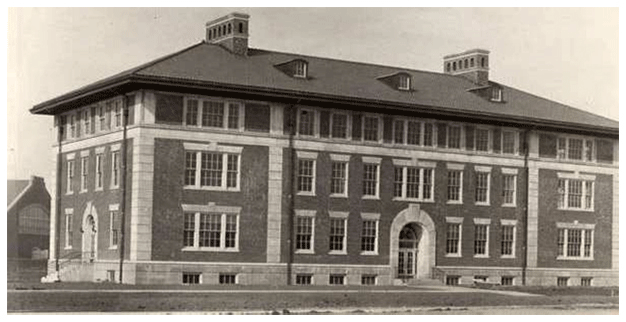 On July 1, 1967, the Department of Geosciences was formed in the School of Science; it was previously a part of the School of Engineering. The geology library materials were stored in the basement of the Chemical and Metallurgical Engineering Building and were a subset of the Civil Engineering Library collection. Marjorie Meyer staffed the library one-quarter time as the library assistant. Dr. Wilton “Bill” Melhorn, the first department head, was instrumental in establishing the Geosciences Library. Dr. Ted V. Jennings, as library committee chair, assisted in selecting library materials to purchase. On July 1, 1967, the Department of Geosciences was formed in the School of Science; it was previously a part of the School of Engineering. The geology library materials were stored in the basement of the Chemical and Metallurgical Engineering Building and were a subset of the Civil Engineering Library collection. Marjorie Meyer staffed the library one-quarter time as the library assistant. Dr. Wilton “Bill” Melhorn, the first department head, was instrumental in establishing the Geosciences Library. Dr. Ted V. Jennings, as library committee chair, assisted in selecting library materials to purchase.
In 1970, the department and library moved across the street into the old Pharmacy Building. Located on the first floor of the Geosciences Building, the library had fire exit doors that overlooked the old fountain situated in front of Hovde Hall of Administration. The library originally consisted of the main room with four study tables and 16 seats, as well as a large room to the immediate southwest. Original built-in wooden shelves and several rows of old army-green surplus shelving housed the entire collection. As the collection grew, the library extended into surrounding rooms, adding three additional rooms before moving to the newly constructed location. The library title morphed from “Geosciences” to “Earth and Atmospheric Sciences” when the department changed names in 1986. In 1988 the Library moved, with the department, to the Civil Engineering Building, now named Hampton Hall of Civil Engineering. The name of the library was changed to “Earth, Atmospheric and Planetary Sciences” in 2012 when the Department of Earth and Atmospheric Sciences underwent a name change to incorporate a new Planetary Sciences major.
Staff
In 1971, after one year in the Mathematical Sciences Library, Carolyn J. Laffoon took the library assistant position in the Earth and Atmospheric Sciences Library (EAS). In 1987, she obtained her Master’s in Library Science from Indiana University, while simultaneously working full-time in the EAS Library. Upon graduation, she was promoted to Professional Librarian of the EAS Library and served in that role until her retirement in 2011.
In 1988, with the move to the new facilities, the university merged the map collection housed in Stewart Center Special Collections with the second campus map collection held by the Department of the Earth and Atmospheric Sciences. Virginia Carter transferred from Special Collections to the EAS Library Map Room as the library assistant and map curator. She worked there until her retirement in 2000. Rebecca Richardson assumed the position of map curator/library assistant and student supervisor the following year, until she finished her Master’s in Library Science. Scott Bonner succeeded Rebecca in 2001 and was the primary force behind merging the two map collections, so library users could easily find maps for themselves. Hired in 2002, Claire Alexander held the position as the map curator/library assistant until her retirement in 2011. Donna Slone worked in the CFS Library from 2004-2007 and moved to Physics where she spent part of her time in Engineering. She moved to EAPS in 2012 and will move to Hicks Library with the map collection. Terry Wade, hired in 1999 as library assistant in Physics Library, splitting her time between Physics and EAS until 2001, when she became a full-time EAS Library assistant supervising the main collection and student staff members.
Over the course of the existence of the EAS library, several faculty librarians have overseen the library, including: Richard Funkhouser, 1970-1980; Martha Bailey, 1980-1982; Dennis Parks, 1982-1986; D. Scott Brandt, 1987-1989; Robert “Pat” Allen, 1990-1997; and Michael Fosmire, 1998-2003, when he was appointed Head, Physical Sciences, Engineering and Technology Division, which included EAS. Megan Sapp Nelson, associate professor, assumed supervision of the EAS library in 2011. She will continue as the liaison to the EAPS department after the closure of the departmental library in 2017.
Additionally, in August, 2006, Chris Miller joined the Purdue Libraries as its first GIS Librarian. Nicole Kong was hired in 2012 as GIS Librarian and two Geographic Information Systems Analysts, Yue (Shirley) Li and Bertin Mbongo were added in 2016.
Collection
The collection consists of research materials primarily for geology, atmospheric sciences, geophysics, geochemistry, hydrogeology and environmental ecology. The EAS Library is a U.S. government depository collecting documents and maps dealing with geology and meteorology. An official depository for the U.S. Geological Survey, it has a fairly complete collection of state survey materials. The map room consists of over 204,000 maps and 140,000 aerial photos, including historical aerial photos of Tippecanoe County. Among the most unique item in the collection is 5 volumes containing the very first original aerial photos ever taken anywhere! They happen to be of the Wabash River Valley, c. 1929. (No other library has this set!) These materials were transferred to Purdue University Libraries' Archives and Special Collections. They were digitized and plans are to add them to the GIS server.
Historical Changes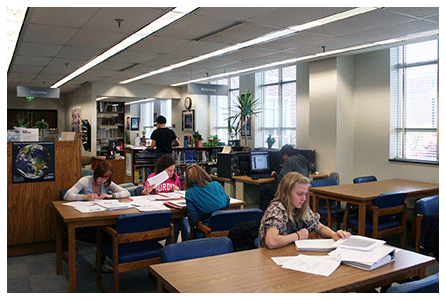
The EAS Library has evolved, along with libraries as a whole, from manual to electronic circulation and overdue materials; from card catalogs to online catalogs, from print reference sources to primarily online databases, such as GeoRef and Meteorological and Geoastrophysical Abstracts (MGA) and reference sources, from face-to-face reference to digital reference (i.e. Ask-A-Librarian service) and email reference, from print journals and books to ejournals and ebooks available on desktop personal computers, and from teaching basic bibliographic instruction classes in the library to teaching classes mostly from computer labs to demonstrate database usage, web searching techniques and webpage evaluation. (Searches that used to take weeks, now take minutes, and even seconds!) |
 |
AROUND THE LIBRARIES
|
Books arrive at the Library of Engineering & Science in the WALC
The move to the new Library of Engineering & Science, Purdue University Libraries inside the Wilmeth Active Learning Center began on Monday, May 15, when the first book was placed on the shelf by Vicki Killion. Faculty and staff from facilities and the former separate Chemistry; Earth, Atmospheric and Planetary Sciences; Life Sciences; Pharmacy, Nursing and Health Sciences; Physics; and Engineering libraries joined together to merge the materials into the consolidated library in the Wilmeth Active Learning Center.
And just like that, on May 18, the massive effort was completed ahead of schedule thanks to many Purdue University Libraries personnel, including faculty, staff and student workers — like Purdue University student Adam Kunkel, seen in the right photo, placing the last book.
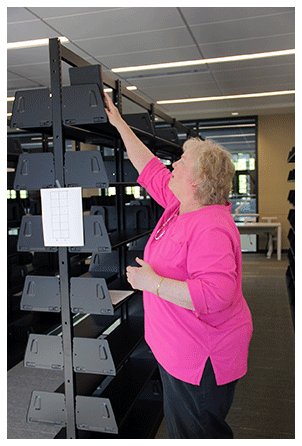 . . 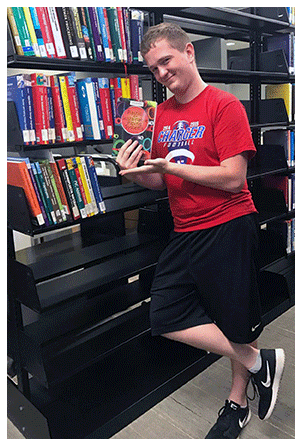
|
|
|
|

 Moving to a new job, a new office, or a new phase of one’s life (retirement in my case) can involve a lot of work, as I discovered while sorting through emails and documents from my 32 years in the Libraries. I inherited most of those in paper format when a colleague retired in 1996 and took on many of the responsibilities I have today. In the process of determining which items to give to Archives and Special Collections (subject to review by ASC staff), and which to recycle, I’m making some curious discoveries. Here are some of them, along with the labels I’ve given to each item and the questions the items raise for me. Hope you enjoy this brief look into the Libraries’ past!
Moving to a new job, a new office, or a new phase of one’s life (retirement in my case) can involve a lot of work, as I discovered while sorting through emails and documents from my 32 years in the Libraries. I inherited most of those in paper format when a colleague retired in 1996 and took on many of the responsibilities I have today. In the process of determining which items to give to Archives and Special Collections (subject to review by ASC staff), and which to recycle, I’m making some curious discoveries. Here are some of them, along with the labels I’ve given to each item and the questions the items raise for me. Hope you enjoy this brief look into the Libraries’ past! Most intriguing find so far – Item: A small envelope, apparently designed for inter-office mail although its dimensions barely exceed those of a dollar bill. Fifty-six delivery locations are listed in tiny print on the front of the envelope, including “Library” and the mysterious “A.R.A. Bldg.” and “Bldg. No. 2.” Question: How old is this small envelope and what were its intended contents?
Most intriguing find so far – Item: A small envelope, apparently designed for inter-office mail although its dimensions barely exceed those of a dollar bill. Fifty-six delivery locations are listed in tiny print on the front of the envelope, including “Library” and the mysterious “A.R.A. Bldg.” and “Bldg. No. 2.” Question: How old is this small envelope and what were its intended contents?
 On April 12, 2017, Dan Yeoman and I set forth on our third off-campus mission for Purdue University Libraries. Our two previous trips involved picking up materials from two of Purdue’s alumni astronauts, Captain Eugene Cernan (May 2010) and Neil Armstrong (2013) after his death. On this trip, we were given the task of picking up material from The University of Wisconsin Library. This collection was 160 volumes of their library’s copy of The National Union Catalog of Pre-1956 Imprints (NUC), which would remain on indefinite loan to the Purdue Libraries.
On April 12, 2017, Dan Yeoman and I set forth on our third off-campus mission for Purdue University Libraries. Our two previous trips involved picking up materials from two of Purdue’s alumni astronauts, Captain Eugene Cernan (May 2010) and Neil Armstrong (2013) after his death. On this trip, we were given the task of picking up material from The University of Wisconsin Library. This collection was 160 volumes of their library’s copy of The National Union Catalog of Pre-1956 Imprints (NUC), which would remain on indefinite loan to the Purdue Libraries. 
 Seeing the National Union Catalog in the Reading Room during the Big Ten Library Conference reception, I realized how appropriate it was to have this collection in the WALC. There has been great effort made to honor and celebrate the history and evolution of this space on campus. People can see the importance and influence of the past. This collection represents a physical artifact in the Evolution of Information and access to it. The processes and media may change, but the importance of providing access and preserving information and knowledge remains. In the WALC, the old and new are brought together all for the purpose of supporting learning.
Seeing the National Union Catalog in the Reading Room during the Big Ten Library Conference reception, I realized how appropriate it was to have this collection in the WALC. There has been great effort made to honor and celebrate the history and evolution of this space on campus. People can see the importance and influence of the past. This collection represents a physical artifact in the Evolution of Information and access to it. The processes and media may change, but the importance of providing access and preserving information and knowledge remains. In the WALC, the old and new are brought together all for the purpose of supporting learning. On July 1, 1967, the Department of Geosciences was formed in the School of Science; it was previously a part of the School of Engineering. The geology library materials were stored in the basement of the Chemical and Metallurgical Engineering Building and were a subset of the Civil Engineering Library collection. Marjorie Meyer staffed the library one-quarter time as the library assistant. Dr. Wilton “Bill” Melhorn, the first department head, was instrumental in establishing the Geosciences Library. Dr. Ted V. Jennings, as library committee chair, assisted in selecting library materials to purchase.
On July 1, 1967, the Department of Geosciences was formed in the School of Science; it was previously a part of the School of Engineering. The geology library materials were stored in the basement of the Chemical and Metallurgical Engineering Building and were a subset of the Civil Engineering Library collection. Marjorie Meyer staffed the library one-quarter time as the library assistant. Dr. Wilton “Bill” Melhorn, the first department head, was instrumental in establishing the Geosciences Library. Dr. Ted V. Jennings, as library committee chair, assisted in selecting library materials to purchase.
 .
. 




